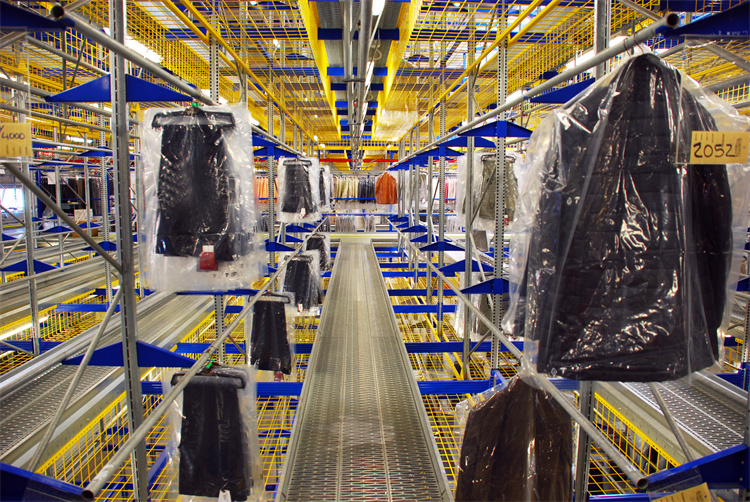Exploring Warehousing and Distribution: A Practical Guide

Warehousing plays a crucial role in the supply chain, ensuring that products are stored safely and efficiently until they reach their final destination. You understand the importance of having a reliable system in place to manage inventory and streamline operations. Efficient logistics are vital in today's fast-paced business environment. In fact, *87% of decision-makers plan to expand warehouses by 2024*, highlighting the growing need for advanced warehousing solutions. Additionally, 80% of organizations aim to invest in new technologies to enhance productivity and performance. By staying informed and adapting to these changes, you can maintain a competitive edge in the market.
Understanding Warehousing

Warehousing serves as a cornerstone in the supply chain, ensuring that products are stored securely until they are needed for distribution or sale. You play a vital role in managing this process, which involves several key functions.
Key Functions of Warehousing
Storage
Storage is the primary function of warehousing. You ensure that goods remain safe and secure until they are required. This involves organizing products in a way that maximizes space and efficiency. Modern warehouses are not just storage spaces; they are organized, clean, and lively hubs for inventory management and product fulfillment. By maintaining a well-organized storage system, you can reduce damage risks and provide insurance coverage for goods.
Inventory Management
Effective inventory management is crucial for business success. You need to keep track of stock levels, manage reordering processes, and ensure that products are available when needed. Modern warehouses utilize advanced technologies to streamline these tasks, making inventory management more efficient and accurate. This helps you minimize storage time and reduce inventory holding costs.
Security
Security is another essential function of warehousing. You must protect goods from theft, damage, and other risks. This involves implementing security measures such as surveillance systems, access controls, and regular audits. By ensuring the safety of stored products, you can maintain trust with your clients and customers.
Types of Warehouses
Warehouses come in various types, each serving different needs and purposes. Understanding these types helps you choose the right solution for your business.
Public Warehouses
Public warehouses offer storage solutions to multiple businesses. They provide flexibility and cost-effectiveness, especially for small to medium-sized enterprises. You can rent space as needed, making it an ideal choice for businesses with fluctuating storage requirements.
Private Warehouses
Private warehouses are owned and operated by a single company. They offer greater control over storage and inventory management processes. If you have consistent storage needs and want to maintain full control over your warehousing operations, a private warehouse might be the best option.
Automated Warehouses
Automated warehouses leverage technology to enhance efficiency and accuracy. They use systems like robotics and automated storage and retrieval systems (AS/RS) to manage inventory. By adopting automation, you can reduce labor costs and improve operational efficiency.
Exploring Distribution
Distribution plays a pivotal role in the supply chain. It ensures that products move efficiently from warehouses to their final destinations. You need to understand the various components of distribution to optimize your logistics operations.
Role of Distribution in the Supply Chain
Distribution involves several key activities that ensure products reach customers promptly and in good condition. Two critical aspects of distribution are transportation methods and order fulfillment.
Transportation Methods
Transportation is the backbone of distribution. You must choose the right transportation method to ensure timely delivery. Options include road, rail, air, and sea transport. Each method has its advantages. Road transport offers flexibility and accessibility. Rail transport provides cost-effective solutions for bulk goods. Air transport ensures speed for urgent deliveries. Sea transport is ideal for international shipping. By selecting the appropriate method, you can balance cost, speed, and reliability.
Order Fulfillment
Order fulfillment is the process of receiving, processing, and delivering orders to customers. You need to ensure that this process is efficient and accurate. Effective order fulfillment involves picking, packing, and shipping products correctly. By optimizing these steps, you can enhance customer satisfaction and reduce errors. Implementing technology, such as automated systems, can streamline order fulfillment and improve efficiency.
Distribution Channels
Distribution channels determine how products reach consumers. You can choose between direct and indirect distribution channels based on your business needs.
Direct Distribution
Direct distribution channels involve selling products directly to consumers. You eliminate intermediaries, allowing for greater control over the sales process. This approach can lead to stronger customer relationships and higher profit margins. Direct channels often include online sales, company-owned stores, and direct mail. By using direct distribution, you can tailor your marketing strategies and offer personalized customer experiences.
Indirect Distribution
Indirect distribution channels involve intermediaries such as wholesalers, retailers, or brokers. These channels can expand your market reach and reduce logistical burdens. Indirect distribution allows you to leverage the expertise and networks of intermediaries. However, it may result in less control over the sales process and lower profit margins. You must carefully select partners to ensure they align with your brand values and goals.
By understanding the role of distribution and choosing the right channels, you can enhance your supply chain efficiency and meet customer demands effectively.
Technology in Warehousing and Distribution

In today's fast-paced world, technology plays a pivotal role in transforming warehousing and distribution. You can leverage these advancements to enhance efficiency, accuracy, and overall performance.
Innovations in Warehousing
Cloud Warehousing
Cloud warehousing revolutionizes how you manage inventory. By utilizing cloud technology, you gain real-time access to data, enabling you to make informed decisions quickly. This technology allows you to track inventory levels, monitor stock movements, and optimize storage space. With cloud warehousing, you can reduce operational costs and improve service levels. The flexibility of cloud solutions also means you can scale your operations as needed, adapting to changing business demands.
Internet of Things (IoT)
The Internet of Things (IoT) brings significant benefits to warehouse management. By implementing IoT devices, you can achieve real-time inventory accuracy and predictive maintenance. These devices help you monitor equipment health, ensuring operational efficiency and reducing downtime. IoT also enhances work quality and productivity by providing valuable insights into warehouse operations. According to recent research, IoT implementation leads to energy savings, improved sales, and increased customer satisfaction. Despite challenges like installation costs and data privacy concerns, the advantages of IoT in warehousing are substantial.
Technological Advancements in Distribution
Automated Vehicles
Automated vehicles are transforming distribution by offering efficient and reliable transportation solutions. You can use these vehicles to streamline logistics operations, reducing the need for manual intervention. Automated vehicles ensure timely deliveries, minimizing human error and enhancing safety. By adopting this technology, you can lower transportation costs and improve delivery accuracy. As automated vehicles become more prevalent, they will play a crucial role in shaping the future of distribution.
Real-time Tracking
Real-time tracking technology provides you with visibility into the entire distribution process. By using GPS and RFID systems, you can monitor shipments in real-time, ensuring that products reach their destinations on time. This technology allows you to address potential issues proactively, enhancing customer satisfaction. Real-time tracking also helps you optimize routes, reducing fuel consumption and transportation costs. By implementing real-time tracking, you can improve supply chain transparency and build trust with your customers.
Incorporating these technological innovations into your warehousing and distribution strategies can significantly enhance your operations. By staying informed and embracing these advancements, you can maintain a competitive edge in the market.
Benefits of Outsourcing to Third-party Logistics Providers
Outsourcing your logistics operations to third-party logistics providers can offer numerous advantages. You can enhance efficiency and reduce costs by leveraging the expertise and resources of specialized logistics companies.
Efficiency and Cost-effectiveness
Reduced Operational Costs
By outsourcing logistics, you can significantly cut down on operational expenses. Third-party providers have established networks and infrastructure, allowing them to offer cost-effective solutions. You avoid the need to invest in warehousing facilities, transportation fleets, and technology systems. This reduction in capital expenditure translates into lower operational costs for your business.
Enhanced Service Levels
Third-party logistics providers bring a wealth of experience and expertise to the table. They can optimize your supply chain processes, ensuring timely deliveries and high service levels. You benefit from their advanced technology and industry knowledge, which leads to improved customer satisfaction. By outsourcing, you can focus on your core business activities while leaving logistics management to the experts.
Case Study: JUSDA's Services
JUSDA, a global supply chain service provider, exemplifies the benefits of outsourcing logistics. Their innovative approach and industry-specific solutions have helped numerous businesses achieve operational excellence.
Best Practices
JUSDA employs best practices in logistics management to enhance efficiency and reduce costs. They utilize advanced technologies such as IoT and cloud computing to streamline operations. These technologies enable real-time collaboration and information sharing across the supply chain. By adopting these practices, you can improve communication, automate processes, and achieve cost savings.
Industry-specific Solutions
JUSDA offers tailored solutions for various industries, including electronic manufacturing, automotive, and medical health. Their industry-specific expertise ensures that you receive customized logistics services that meet your unique needs. By partnering with JUSDA, you gain access to a robust network of service points and a vast warehouse area. This extensive infrastructure supports efficient logistics operations and enhances your supply chain capabilities.
"JUSDA's commitment to innovation and efficiency positions it as a key player in the global logistics and supply chain industry."
Outsourcing to third-party logistics providers like JUSDA can transform your supply chain operations. You can achieve greater efficiency, reduce costs, and enhance service levels by leveraging their expertise and resources.
Optimizing Warehousing and Distribution Strategies
Optimizing your warehousing and distribution strategies can significantly enhance your business operations. By focusing on efficiency and leveraging technology, you can improve accuracy, reduce costs, and boost customer satisfaction.
Practical Tips for Businesses
Streamlining Operations
To streamline your warehousing operations, focus on optimizing the use of time, space, and resources. Implementing a modern warehousing solution can lead to significant efficiency improvements. By utilizing advanced technology, you can reduce manual labor and enhance the accuracy of picking. This ensures that customers receive the correct products on time, reducing return rates and boosting satisfaction.
Consider the following steps to streamline your operations:
Organize Inventory: Arrange products logically to maximize space and facilitate easy access. This reduces the time spent locating items and speeds up the fulfillment process.
Implement Automation: Use automated systems for tasks like sorting, picking, and packing. Automation minimizes human error and increases efficiency.
Regularly Review Processes: Continuously assess and refine your workflows to identify areas for improvement. This helps maintain optimal performance and adapt to changing demands.
Leveraging Technology
Technology plays a crucial role in optimizing warehousing and distribution. With so many moving parts, data can quickly get out of sync if you track things manually. By integrating technology, you ensure smoother processes and reduce errors.
Here are some ways to leverage technology effectively:
Adopt Warehouse Management Systems (WMS): A WMS provides real-time data on inventory levels, order status, and warehouse activities. This information helps you make informed decisions and optimize operations.
Utilize IoT Devices: Internet of Things (IoT) devices offer real-time inventory accuracy and predictive maintenance. They help monitor equipment health, ensuring operational efficiency and reducing downtime.
Implement Real-time Tracking: Use GPS and RFID systems to monitor shipments throughout the distribution process. Real-time tracking enhances transparency and allows you to address potential issues proactively.
By implementing these strategies, you can optimize your warehousing and distribution operations. This not only improves efficiency but also enhances the overall customer experience.

After the update
Supply Chain Management Solution
In this guide, you explored the essential roles of warehousing and distribution in the supply chain. You learned about the importance of storage, inventory management, and security in warehousing. You also discovered how distribution channels and transportation methods ensure products reach customers efficiently. By implementing these strategies, you can enhance operational efficiency and reduce costs. As technology advances, you should embrace innovations like IoT and real-time tracking to stay competitive. The future of warehousing and distribution promises even greater efficiency and collaboration, paving the way for sustained success in a dynamic market.
See Also
Maximizing Warehouse Efficiency with Logistics Robotics Technology
Expert Strategies for Effective Supply Chain Risk Management
Unveiling the Benefits of Robotic Automation in Warehousing
Navigating Supply Chain Disruptions: An In-Depth Manual
Ensuring Smooth Operations: The Key to Supply Chain Risk Management
